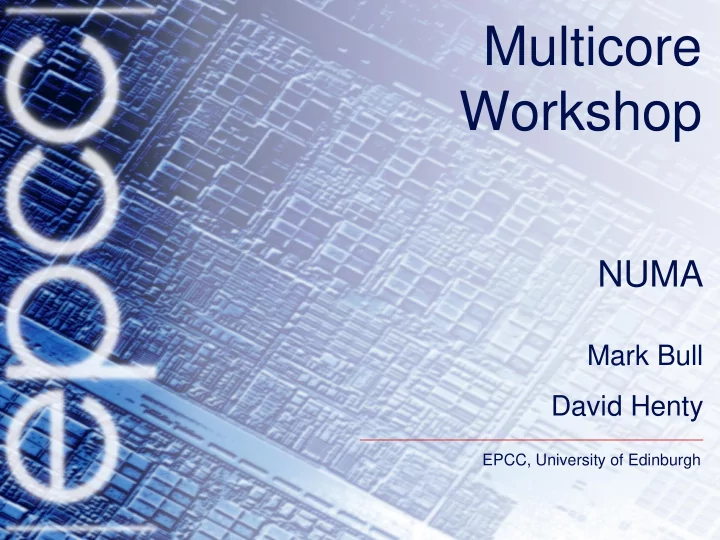

Multicore Workshop NUMA Mark Bull David Henty EPCC, University of Edinburgh
Distributed shared memory • Shared memory machines using buses and a single main memory do not scale to large numbers of processors – bus and memory become a bottleneck • Distributed shared memory machines designed to: – scale to larger numbers of processors – retain a single address space • Modest sized multi-socket systems connected with HyperTransport or QPI are, in fact, distributed shared memory • Also true of recent multicore chips – multiple “dies” on a single chip (i.e. single socket) 20/11/2012 NUMA 2
True shared memory P P P P P P Network Memory Examples: Sun X4600, all multicore PCs, IBM p575, NEC SX8, Fujitsu PRIMEQUEST 20/11/2012 NUMA 3
Distributed shared memory P P P P P P P P P P P P P P P P M M M M M M M M Network 20/11/2012 NUMA 4
Directory based coherency • For scalability, there is no bus, so snooping is not possible • Instead use a directory structure – bit vector for every block – one bit per processor – stored in (distributed) memory – bit is set to 1 whenever the corresponding processor caches the block. • Still some scalability issues: – directory takes up a lot of space for large machines – e.g. 128 byte cache block, 256 processors: directory is 20% of memory – some techniques to get round this 20/11/2012 NUMA 5
Implementation • Node where memory (and directory entry) is located is called the home node. • Basic principal is same as snoopy protocol – cache block has same 3 states (modified, shared, invalid) – directory entry has modifed, shared and uncached states. • Cache misses go to the home node for data, and directory bits are set accordingly for read/write misses. • Directory can: – invalidate a copy in a remote cache – fetch the data back from a remote cache • Cache can write back to home node. 20/11/2012 NUMA 6
cc-NUMA • We have described a distributed shared memory system where every memory address has a home node. • This type of system is known a a cache-coherent non- uniform memory architecture (cc-NUMA). • Main problem is that access to remote memories take longer than to local memory – difficult to determine which is the best node to allocate given page on • OS is responsible for allocating pages • Common policies are: – first touch: allocate on node which makes first access to the page – round robin: allocate cyclically 20/11/2012 NUMA 7
Migration and replication • Possible for the OS to move pages between nodes as an application is running • Pages can either be migrated or replicated. • Migration involves the relocation of a page to a new home node. • Replication involves the creation of a “shadow” of the page on another node. – read miss can go to the shadow page • Cache coherency is still maintained by hardware on a cache block basis. 20/11/2012 NUMA 8
Recommend
More recommend